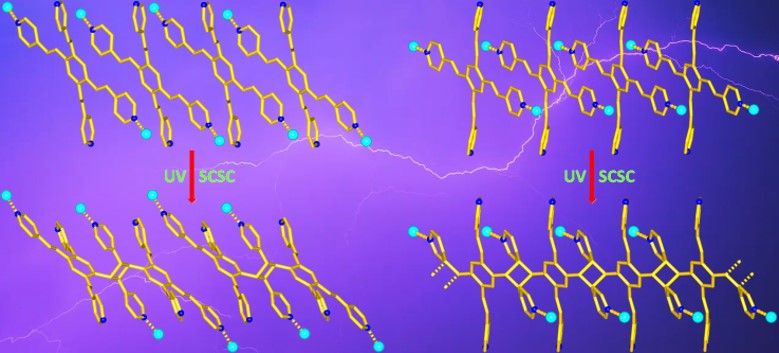Tetraolefin stereospecific photodimerization and photopolymerization in coordination polymers
Wei-Jie Gong, Zhan-Yong Yang, Yu-Xuan Hong, Dong Liu, Zheng Niu, Pierre Braunstein& Jian-Ping Lang

In the context of the highly desirable design and preparation of smart materials with adjustable properties based on photoreactive compounds, we report two unique photoreactive coordination polymers (CPs),{[Zn(4-Iba)2(4-tkpvb)]·H2O}n (1, 4-HIba = 4-iodobenzoic acid, 4-tkpvb = 1,2,4,5-tetrakis(4-pyridylvinyl)benzene) and [Cd(1,4-bdc)(4-tkpvb)]n (2, 1,4-H2bdc = 1,4-benzenedicarboxylic acid). Depending on the metal ions and auxiliary carboxylate ligands used, the 4-tkpvb ligands in 1 and 2 adopt different mutual arrangements, which facilitate the photodimerization and photopolymerization reactions in single crystal to single crystal (SCSC) transformations. Upon UV light irradiation which results in the dimerization of the 4-tkpvb ligands, the one-dimensional (1D) zigzag chainsof 1 are transformed into a two-dimensional (2D) network of {[Zn(4-Iba)2(bpbtpvcb)0.5]·H2O}n (1a, bpbtpvcb = 1,3-bis(4-pyridyl)-2,4-bis(2,4,5-tri(2-(4-pyridyl)vinyl) phenylcyclobutane). Similarly, in the crystals of 2, all 4-tkpvb ligands experience a photopolymerization reaction to form an unprecedented 1D linear organic polymer, poly-1,3-bis(4-pyridyl)-2,5-bis(2-(4-pyridyl)-vinyl) phenyl)cyclobutane (poly-bpbpvpcb). Furthermore, the 2D network of 2 is converted into a three-dimensional (3D) framework of [Cdn(1,4-bdc)n(poly-bpbpvpcb)] (2a). This work not only offers a new protocol to selectively synthesize new supramolecular cyclic compounds, but also expands the application of photopolymerization to the synthesis of macromolecules.
配位聚合物中的四烯烃立体定向光二聚和光聚合
在基于光反应化合物的具有可调节性能的智能材料的高度理想设计和制备的背景下,我们报告了两种独特的光反应配位聚合物(CP),{[Zn(4-Iba)2(4-tkpvb)]·H2O}n(1,4-HIba=4-碘苯甲酸, 4-tkpvb = 1,2,4,5-四(4-吡啶基乙烯基)苯)和[Cd(1,4-bdc)(4-tkpvb)]n(2, 1,4-H2bdc = 1,4-苯二甲酸)。根据所使用的金属离子和辅助羧酸盐配体,1和2中的4-tkpvb 配体采用不同的相互排列方式,这有利于单晶向单晶(SCSC) 转变中的光二聚化和光聚合反应。在导致4-tkpvb 配体二聚化的紫外光照射下,将1的一维(1D)之字形链转换为{[Zn(4-Iba)2(bpbtpvcb)0.5]·H2O}n(1a, bpbtpvcb = 1,3-bis)的二维(2D)网络(4-吡啶基)-2,4-双(2,4,5-三(2-(4-吡啶基)乙烯基)苯基环丁烷)。同理,在2的晶体中,所有4-tkpvb 配体都经历光聚合反应,形成前所未有的一维线性有机聚合物poly-1,3-bis(4-pyridyl)-2,5-bis(2-(4-pyridyl)-乙烯基)苯基)环丁烷(聚-bpbpvpcb)。此外,将2的2D网络转换为[Cdn(1,4-bdc)n(poly-bpbpvpcb)](2a)的三维(3D)框架。该工作不仅为选择性合成新的超分子环状化合物提供了一种新的方案,而且扩大了光聚合在大分子合成中的应用。
DOI: 10.1007/s12274-021-3475-z

